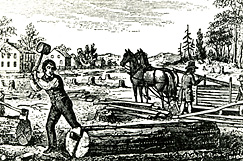colonial period
Indentured Servitude in Colonial Springfield
The life and experiences of Peter Swink, a black servant of the Pynchon family in Springfield, provides clues as to the potential status of such laborers in the area. The town records note Swink's arrival in 1659 and his death in 1699. During that forty-year span, Swink gained his freedom and became a landowner. In January of 1662, Elizur Holyoke recorded the following transaction at a town meeting: "There's granted to Peter Swink, Capt Pynchons servant, vacant land, lyes between the [general] fence from [the] great River to Agawam River & is granted on condition [that] he live till his tyme be expired & that he settle his abode there on Said lott." 1 Swink continued to purchase land throughout the 1660s and amassed over 60 acres by the end of the decade.
Swink's ability to expand his property holdings demonstrates a flexibility in racial constraints that contradicts some preconceptions of the colonial period. Swink's value in the Springfield community was not dictated by his black skin but, rather, Swink's fulfillment of his labor contract earned him the favor of influential men, such as Pynchon and Elizur Holyoke. Further evidence of interchange between the races is provided by the seating plan for town meetings. The community granted Swink a position in the tenth row beginning in December of 1659, and he held that seat for the rest of his life. 2
A second example found through local records is the case of John Stewart, indentured to the Pynchon family in 1656. John Pynchon signed the following contract defining Stewart's bonded service: "I agree with John Stewart to allow me yearly twelve shillings in Smithery work for 3 years." 3 After completing his term of servitude, Stewart, "a thrifty and bustling Scotch-man, whose early adventures made him an interesting character," 4 served the town as a blacksmith until his death in 1691. Like Peter Swinke, Stewart received a seat at town meetings and occupied a space in the seventh row. 5 Reasons for the difference in placement of the two former servants remain unclear.
A third indentured servant, John Mathews, arrived in Springfield in 1643. Through the aide of the Pynchon family, Mathews completed his contract and went to work as a successful cooper, until his death in 1684. In addition to his professional success, Mathews also became a land owner: "There's granted to John Mathews 20 acres of land," notes the town meeting record of February 8, 1663. 6 Mathews occupied a seat in the fifth row in all town meetings. Again, the reasons for the seating arrangements remain open to speculation.
The stories of these three men provide hints about the experiences of indentured servants in colonial Springfield and illustrate the kinds of economic opportunities that attracted immigrants to the colonies. The ability of contract laborers to become professional men, and the chance to acquire considerable property holdings, demonstrate the fluid nature of social class and economic status during this period. After the American War for Independence and the Industrial Revolution, immigrants were still drawn to the United States by economic opportunities here. As the country became more ethnically and racially diverse, however, and class distinctions became more stark, ethnic minorities and immigrant groups frequently found themselves at the bottom of the socioeconomic ladder.
1
Henry M. Burt,
The First Century of the History of Springfield: The Official Records from 1636- 1736
(Springfield: Henry M. Burt Publisher, 1898), 302-3. Spelling and grammar in original text.
2
Burt, 126-7.
3
Burt, 64.
4
Burt, 62.
5
Burt, 127.
6
Burt, 312.
